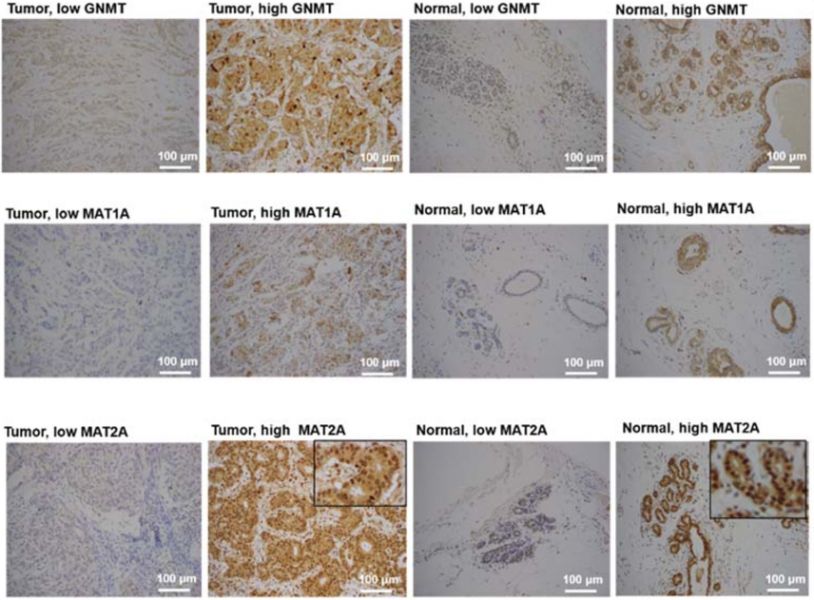循環農業:農業廢棄物再資源化【食品暨應用生物科技學系/蔣恩沛特聘教授】
| 論文篇名 | 英文:MAT2A Localization and Its Independently Prognostic Relevance in Breast Cancer Patients 中文:MAT2A 定位與其在乳腺癌患者中的獨立預後相關性 |
| 期刊名稱 | International Journal of Molecular Sciences |
| 發表年份,卷數,起迄頁數 | 2021, 22(10), 5382 |
| 作者 | Chu, Pei-Yi; Wu, Hsing-Ju; Wang, Shin-Mae; Chen, Po-Ming; Tang, Feng-Yao; Chiang, En-Pei Isabel(蔣恩沛)* |
| DOI | 10.3390/ijms22105382 |
| 中文摘要 | (1) 背景:甲硫胺酸循環不僅對癌細胞增殖至關重要,而且對代謝重整 (癌症標共同特徵) 也至關重要。肝和肝外組織甲硫胺酸腺苷轉移酶 (MAT) 是兩個基因 MAT1A 與 MAT2A 的產物,它們催化 S-腺苷甲硫胺酸 (SAM) - 主要生物甲基提供者的形成。甘胺酸 N-甲基轉移酶 (GNMT) 進一步利用 SAM 形成肌胺酸,從而調節 SAM:S-腺苷高半胱胺酸 (SAH) 的比例。(2) 方法:通過分析 GEPIA2 中可用的 TCGA/GTEx 數據集,我們發現 MAT2A 較高的乳腺癌患者的生存率較差 (p=0.0057)。通過免疫組織化學在我們自己群組 (n = 252) 的組織微陣列中研究了 MAT1A、MAT2A 及 GNMT 的蛋白質表達模式。在一組乳腺癌細胞系中進一步研究了 MAT2A C/N 表達比和細胞侵襲活性。(3) 結果:在細胞質中檢測到 GNMT 與 MAT1A,而 MAT2A 同時表現出細胞質和核免疫反應性。在我們的群組中,GNMT 與 MAT1A 蛋白表達均與患者存活率無關。 Kaplan-Meier 生存曲線顯示,較高的細胞質/核 (C/N) MAT2A 蛋白表達比率與較差的總體生存率相關 (5 年生存率:93.7% 與 83.3%,C/N 比率 ≥1.0 與 C/N比率 <1.0,對數秩 p=0.004)。因此,通過 Cox 回歸分析 (風險比 =2.771,p=0.018,n=252) 將 MAT2A C/N 表達比 ≥1.0 確定為獨立危險因素。體外研究發現,具有較高 MAT2A C/N 比的乳腺癌細胞株更具侵襲性。(4) 結論:MAT2A 的亞細胞定位可能影響其功能,乳腺癌細胞中MAT2A C/N比升高與侵襲性增加有關。通過 IHC 染色確定的 MAT2A C/N 表達比可以作為乳腺癌的新型獨立預後標誌物。 |
| 英文摘要 | (1) Background: methionine cycle is not only essential for cancer cell proliferation but is also critical for metabolic reprogramming, a cancer hallmark. Hepatic and extrahepatic tissues methionine adenosyltransferases (MATs) are products of two genes, MAT1A and MAT2A that catalyze the formation of S-adenosylmethionine (SAM), the principal biological methyl donor. Glycine N-methyltransferase (GNMT) further utilizes SAM for sarcosine formation, thus it regulates the ratio of SAM:S-adenosylhomocysteine (SAH). (2) Methods: by analyzing the TCGA/GTEx datasets available within GEPIA2, we discovered that breast cancer patients with higher MAT2A had worse survival rate (p = 0.0057). Protein expression pattern of MAT1A, MAT2A and GNMT were investigated in the tissue microarray in our own cohort (n = 252) by immunohistochemistry. MAT2A C/N expression ratio and cell invasion activity were further investigated in a panel of breast cancer cell lines. (3) Results: GNMT and MAT1A were detected in the cytoplasm, whereas MAT2A showed both cytoplasmic and nuclear immunoreactivity. Neither GNMT nor MAT1A protein expression was associated with patient survival rate in our cohort. Kaplan-Meier survival curves showed that a higher cytoplasmic/nuclear (C/N) MAT2A protein expression ratio correlated with poor overall survival (5 year survival rate: 93.7% vs. 83.3%, C/N ratio ≥ 1.0 vs. C/N ratio < 1.0, log-rank p = 0.004). Accordingly, a MAT2A C/N expression ratio ≥ 1.0 was determined as an independent risk factor by Cox regression analysis (hazard ratio = 2.771, p = 0.018, n = 252). In vitro studies found that breast cancer cell lines with a higher MAT2A C/N ratio were more invasive. (4) Conclusions: the subcellular localization of MAT2A may affect its functions, and elevated MAT2A C/N ratio in breast cancer cells is associated with increased invasiveness. MAT2A C/N expression ratio determined by IHC staining could serve as a novel independent prognostic marker for breast cancer. |
| 發表成果與本中心研究主題相關性 | 代謝路徑追蹤之應用 |







